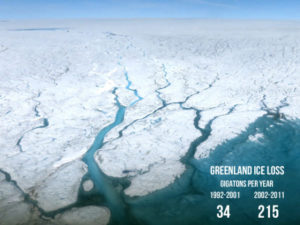
Melt streams on the Greenland Ice Sheet on July 19, 2015. Ice loss from the Greenland and Antarctic Ice Sheets as well as alpine glaciers has accelerated in recent decades. NASA
Credit: Maria-José Viñas.
As the ice sheets of the world melt, an enormous amount of pressure will be lifted off of the continental crusts that play host to them, as well as the surrounding oceanic basins. Something similar is broadly true, but to a much lesser degree, of the world’s remaining large glaciers (think of the Himalayas).
As this pressure is lifted, after tens of millions of years of being there, tectonic and volcanic features that have been dormant for hundreds of thousands of years or even tens of millions of years will awake — as will broader geologic-system elements and processes.
The ice sheets of East Antarctica have effectively been there in one form or other for ~15 million years (to a lesser extent than now, though), while a portion of the Greenland ice sheet is thought to have partially melted around 120,000–130,000 years ago […]












This was the long read for early Sunday morning. 🙂 I’ve been spending a great deal of time grieving all of this, with the impending loss of all multicellular life on Earth. It’s become increasingly more difficult to avoid all this murder and mayhem accompanied by a rock ‘n roll soundtrack.
I was introduced to the concept of the 6th great extinction with a group of people studying Brian Swimme and Father Thomas Berry in 1999. Brian taught that in 1990, scientists were not aware that this was going on. He further stated that scientists were also unaware that people were the cause. Now we know that humans are not only the cause, *but*, included in that event, which is ongoing, accelerating, with no final conclusion handed down on any tablet timeline.
Stephan, you are a huge proponent of the non local consciousness. Concomitant to that, there must also be a non local unconscious. I feel very strongly that the rash of unprovoked mass murders either in the schools of the US or the van attacks as what transpired last week in Toronto, are harbingers of this latter form of societal human angst, this great unconscious realization that the ship is out of control; that “the captains of industry and their fools on the hill” to quote Don Henley, have no idea how to refocus the boats, since well being for all, which includes them as well as their loved ones, is not even conceived of.
Perhaps the reason we today have a chance to look back on the failed civilizations of history as maybe, just maybe, that’s The Universe’s way of showing the current generations alive, that it happened and that it can happen again. Yet another way of awakening.
If a public meditation on a global scale could be organized to raise the consciousness of humanity that all are in this together . . . I dunno. Recently, I’ve been citing the 1993 TM DC murder meditation sit-in, where the mayor of Washington stated that the murder rate had gone down that month by 23%. That’s real history which no one faked. 🙂